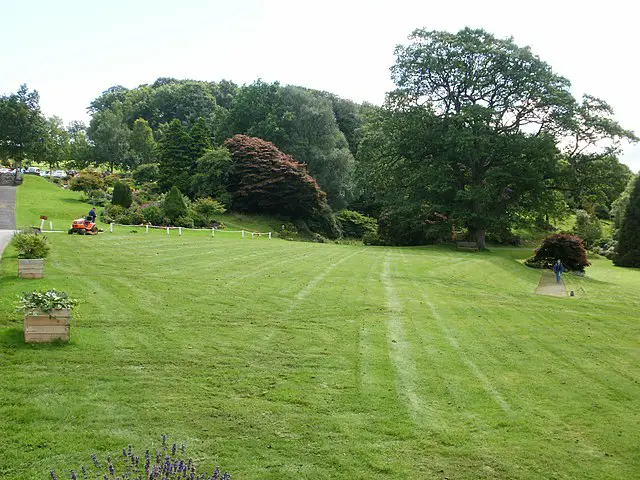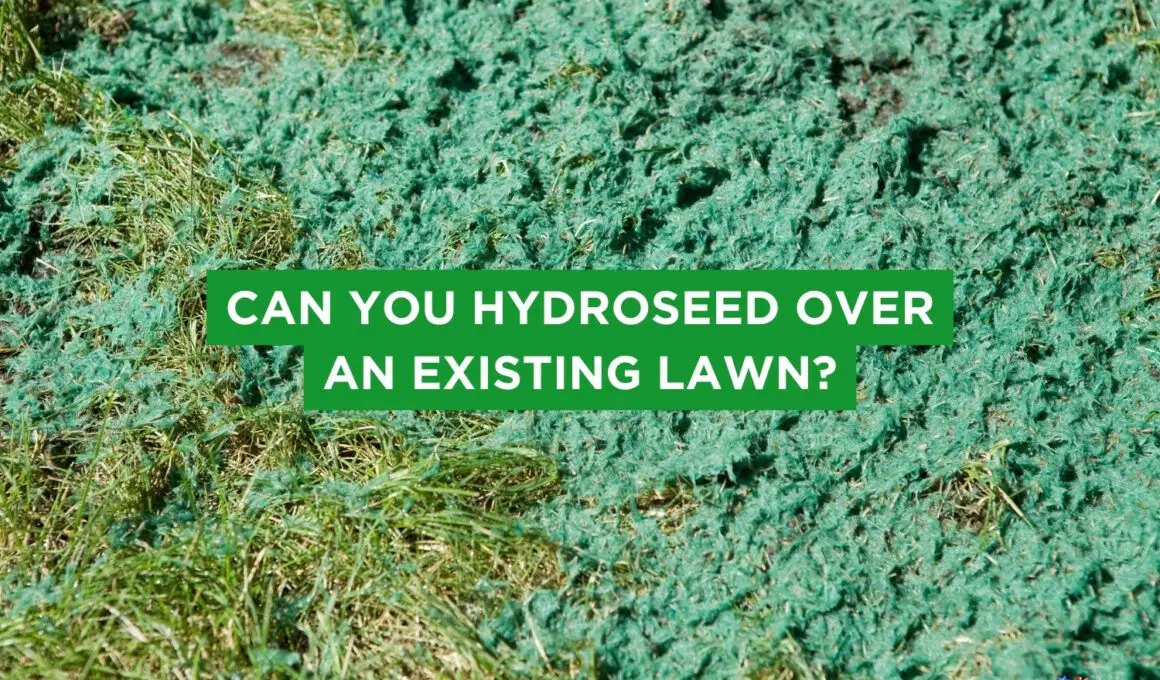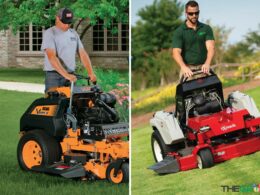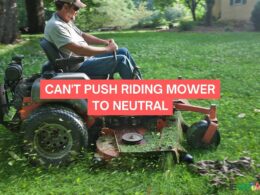In This Article Show
In the world of lawn care and landscaping, new methods and technologies are constantly emerging. One of these, hydroseeding, has gained much attention for its effectiveness in establishing new lawns and repairing damaged ones.
But can you hydroseed over an existing lawn? This is a question I’ve been asked numerous times throughout my 13-year career in lawn care, and today, we’re going to thoroughly explore this topic.
Hydroseeding, despite its scientific-sounding name, is a process that’s quite straightforward and, in fact, ingeniously simple. It involves spraying a mixture of water, seeds, mulch, and fertilizer over a predetermined area to encourage new grass growth. This technique can bring even the most beleaguered lawns back to life.
As a seasoned lawn care expert, I’ve personally witnessed the transformative power of hydroseeding and believe it can be an excellent tool for homeowners looking to enhance their landscapes.
But is hydroseeding a viable option for an existing lawn? To answer this question, we first need to delve deeper into what hydroseeding entails, the state of your lawn, and the various factors you need to consider when deciding to hydroseed.
Understanding Hydroseeding
In my extensive 13-year career in lawn care, hydroseeding has proven to be a game-changer for many of my clients’ lawns. To fully grasp the potential of hydroseeding over an existing lawn, we first need to comprehend what hydroseeding is and how it works.
Get Gardening For Beginners
Our new EBOOK shows newcomers and green thumbs alike a step by step guide to growing the garden of their dreams.
Essentially, hydroseeding is a planting process that uses a slurry of seed and mulch. This mixture is often combined with fertilizer and a bonding agent that helps it adhere to the soil. It’s sprayed onto the ground using a hose, providing a uniform layer that promotes rapid seed germination and growth.
The protective mulch layer retains moisture and defends the seeds against erosion and birds, all while providing nutrients as it decomposes.
Hydroseeding is popularly used to establish new lawns, control erosion on slopes and hillsides, and repair areas damaged by construction or natural disasters. It is faster, more cost-effective, and has higher germination rates compared to traditional seeding methods. When done correctly, the result is a lush, green, and evenly grown lawn.
However, the advantages of hydroseeding go beyond just its cost-effectiveness and efficiency. It also offers significant flexibility, with the ability to custom-tailor the seed mix to your specific lawn needs. This can include anything from a mixture that’s perfect for shady yards to one that’s designed to withstand heavy foot traffic.
In essence, hydroseeding is a robust lawn care tool that can bring immense benefits to your property. As a lawn care expert, I’ve seen these advantages play out on countless occasions. But does this tool work on all lawns, specifically existing ones?
The State of Your Lawn

Before considering hydroseeding or any lawn renovation method, it’s important to assess the current condition of your lawn. Identifying the problems your lawn is facing is the first step in determining the best solution.
Common issues that plague lawns include uneven growth, bald patches, and a lack of lushness and green color. These issues can be due to various reasons such as poor soil conditions, inadequate water, pests, disease, or heavy foot traffic.
Get Gardening For Beginners
Our new EBOOK shows newcomers and green thumbs alike a step by step guide to growing the garden of their dreams.
In many cases, these problems can be addressed with regular maintenance practices like watering, fertilizing, and aerating. However, when these issues become severe or pervasive, lawn renovation may be necessary.
Lawn renovation involves improving the existing lawn without completely replacing it. This could mean overseeding to fill in sparse areas, aerating to alleviate soil compaction, or in some cases, hydroseeding to provide a boost of nutrients and seeds to your lawn.
But is hydroseeding a viable option for your existing lawn?
Can You Hydroseed Over an Existing Lawn?
So, let’s get straight to the point: Can you hydroseed over an existing lawn? The answer is yes but with some caveats.
The feasibility of hydroseeding over an existing lawn largely depends on the state of your lawn. If the lawn is sparse with a lot of exposed soil, hydroseeding can be an effective method to fill in the bare spots and promote uniform growth.
However, if your lawn is heavily weeded or diseased, it’s usually best to address these issues first before considering hydroseeding.
Factors to Consider
When you decide to hydroseed over an existing lawn, certain factors should be considered for the best results:
1. Lawn Preparation
You should first mow your lawn as short as possible, rake away the clippings, and aerate the soil. This helps to expose the soil surface and create conditions that are ideal for the seeds to germinate.
2. Custom Seed Mix
Depending on your lawn’s needs, a custom seed mix can be created. This mix should be tailored to the specific needs of your lawn, whether it be shade tolerance, drought resistance, or wear tolerance.
3. Proper Application
The hydroseed mixture should be applied uniformly over the existing lawn. This can be challenging to do by hand, so professional hydroseeding services may be beneficial.
4. Post-care
After hydroseeding, the lawn needs to be watered lightly and frequently until the new grass reaches mowing height. This keeps the seeds moist and promotes germination.
Like any lawn care method, hydroseeding over an existing lawn has its pros and cons. On the plus side, it can rejuvenate a thinning lawn quickly and cost-effectively, with the added benefit of customizing the seed mixture to your lawn’s specific needs.
On the downside, it’s less effective on lawns that are heavily weeded or diseased and may require professional services for the best results.
Understanding these factors can help you decide if hydroseeding over an existing lawn is right for you. But to ensure success, there are some additional tips you should consider, which we’ll discuss next.
Tips For Successful Hydroseeding
If you decide to hydroseed over your existing lawn, there are some key steps to follow to ensure success. After all, every lawn is unique and what works for one might not necessarily work for another. Here are some handy tips to guide you through the process:
1. Prepare Your Lawn
Start by mowing your lawn as short as possible without scalping it. This helps expose more soil for the hydro seed mix to make contact with. Next, rake away any clippings and debris, and if possible, aerate your lawn. This enhances seed-to-soil contact and improves germination.
2. Choose the Right Seed Mix
Choosing the right seed mix for your lawn’s specific needs is crucial. Consider factors like the amount of sunlight your lawn receives, the climate of your region, and the intended use of your lawn.
3. Even Application
For the best results, the hydroseed mixture should be applied evenly across the entire lawn. This ensures uniform growth and avoids patches. Hiring professional hydroseeding services may be beneficial to achieve this.
4. Proper Watering
Post-hydroseeding care is just as important as the application process. The hydroseed area should be kept moist at all times until the seeds germinate. This generally means watering lightly but frequently.
5. Watch for Warning Signs
Post-hydroseeding, keep an eye out for any problem signs such as uneven germination, pooled water, or signs of disease. If you notice anything unusual, consult with a lawn care professional to address the issue promptly.
While hydroseeding can be an effective solution for an existing lawn, it’s not the only lawn renovation method out there.
Alternative Methods for Lawn Renovation

In my 13 years of lawn care experience, I’ve discovered that while hydroseeding can be an excellent solution for rejuvenating a thin or patchy lawn, there are other equally effective methods worth considering. Choosing the right one often depends on your specific circumstances and lawn health.
- Overseeding: This involves spreading grass seed over an existing lawn. Like hydroseeding, it’s often used to improve the density of thin lawns and introduce a more resilient grass type. However, it might not be as effective as hydroseeding in areas with poor soil or severe lawn damage.
- Sodding: Sodding provides an instant lawn solution and is great if you want quick results. However, it’s more expensive than hydroseeding and overseeding, and it requires a lot of preparation and cares to ensure the sod establishes well.
- Aerating and Dethatching: If your lawn is compacted or has a thick layer of thatch, aerating, and dethatching can greatly improve its health. These processes improve water, nutrient, and airflow to the grassroots, promoting a healthier and denser lawn.
- Top Dressing: This involves adding a thin layer of compost or soil mix over your lawn. It can help improve soil quality, level out uneven areas, and introduce beneficial microorganisms.
All these methods have their own benefits and drawbacks, just like hydroseeding. The key is to choose the method that suits your lawn’s specific needs and your own budget and time constraints.
As a lawn care expert, I recommend getting a thorough understanding of each method and considering factors like lawn condition, local climate, and the specific challenges your lawn is facing before deciding on the best course of action. Whether it’s hydroseeding, overseeding, or another method, what matters most is making an informed decision for the health and beauty of your lawn.
Wrapping it up
Navigating the world of lawn care can often feel like navigating a maze, with various paths leading to different outcomes. However, understanding the tools at your disposal, such as hydroseeding, can make this journey significantly easier.
Yes, you can hydroseed over an existing lawn, but it’s essential to consider the current state of your lawn, the necessary preparation, and the post-care requirements to ensure success. Moreover, while hydroseeding can be an excellent method for rejuvenating your lawn, it’s not the only option.
Other methods like overseeding, sodding, aerating, and top dressing can also be effective, depending on your specific circumstances and needs.










